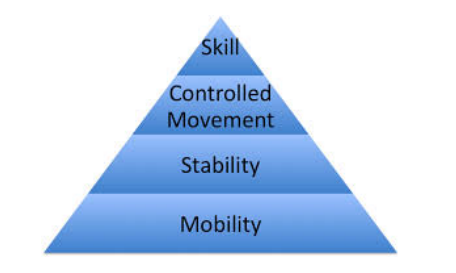Mobility Vs Flexibility
Jan 28, 2019
by Bryan Preston
Mobility vs Flexibility
What's The Difference?
We hear these terms all the time and mobility is all the rage. Flexibility is a more common term for the general masses. What do they mean? Aren't they the same thing? The short answer is no. Although they are directly related to each other and both play a role in movement, they are different. Movement is related to both mobility and flexibility and not to be confused as the same.
One definition for flexibility states, "the quality of bending easily without breaking." Another, "willingness to change or compromise." These don't really help us understanding how this relates to movement patterns or body parts. With flexibility we often associate it with stretching or gaining range of motion. How far can you raise your leg up during a straight leg right while lying on your back due to hamstring flexibility. Being able to perform a front split due to things like hamstring and hip flexor range of motion for example. So, for our purposes, we are going to think of range of motion for individual muscles and how it relates to movement. We are also going to put aside any structural defects that could limit range of motion for this conversation.
Mobility is really a combination of flexibility and strength. I could be flexible enough to sit on the floor in a runner’s stretch and touch my toes but not be able to kick above waist high due to a lack of strength and stability. Mobility is going to add a layer of functional strength on top of our flexibility. Mobility is also going to involve multiple body parts moving together in compound movement patterns. A squatting pattern is going to involve things like good range of motion at the ankle and hip but also require good glute and quad strength. All of these and more are involved in being able to perform a proper squat.
Stability also plays an important role with our strength and flexibility to produce quality mobility. Someone could have enough strength and range of motion to raise their arm over their head but lack the stability needed to raise their arm without compensating. We might see someone lean back or hike their shoulder in order to raise their arm up higher. Maybe they can place an item on a high shelf but can’t do it pain free due to the deficit.
So, in order to produce good, quality movement, we need to bring all these pieces of the puzzle together. Good flexibility, strength, mobility, stability is the foundation of quality movement. Movement takes mobility to the next level. A crawling pattern, for example like a bear crawl, is a full body movement that integrates all of these components. A bear crawl is going to require good stability at the shoulders and hips, core strength, and range of motion. A bear crawl can expose deficits due to a lack of mobility or flexibility in any of these areas. It is common to see someone lift their butt high in the air or unable to hold the position due to these deficits.
Movement is about so much more than just bear crawling. Movement is everyday life. Walking, going upstairs, getting in and out of the car. Going on adventures with friends and getting out and enjoying life. Our health and fitness should complement our life and make us feel better and move better. Good mobility and flexibility with strength and stability will allow us to move better for longer and enjoy life.
About The Author: Bryan Preston has over 25 years of training in martial arts and fitness and is a Physical Therapist Assistant. A 3rd degree black belt in Tae Kwon Do and a black belt in Brazilian Jiu Jitsu. Bryan is the hand to hand tactics instructor for Ghost Ring Tactical and holds many certifications in fitness and nutrition including person trainer, FMS, kettlebell, Precision Nutrition Level 2, Certified RockDoc and more. Bryan has been teaching in the Marlton/Medford area to children and adults from ages 3 years old and up.

